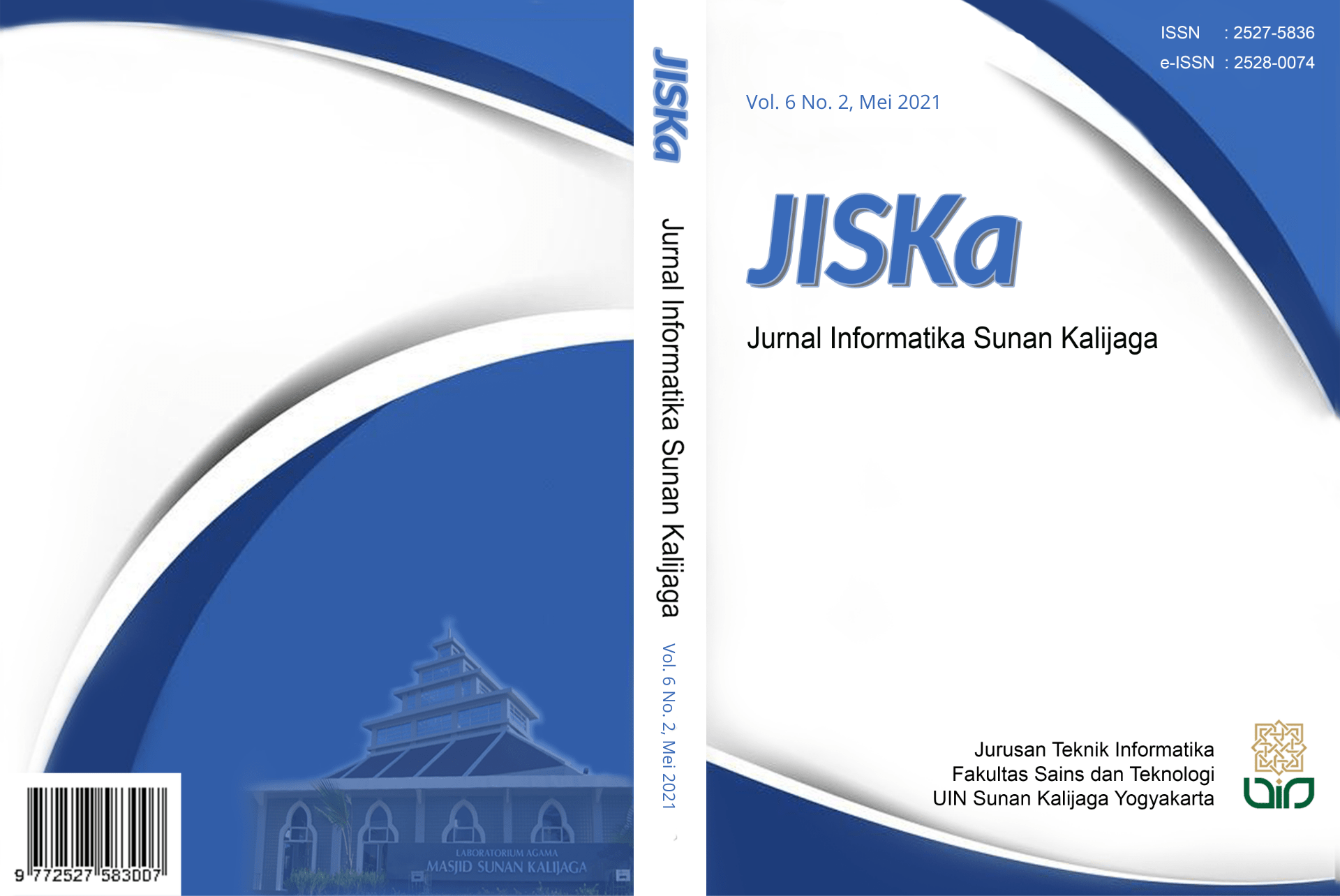Analisis Hashtag pada Twitter untuk Eksplorasi Pokok Bahasan Terkini Mengenai Business Intelligence
DOI:
https://doi.org/10.14421/jiska.2021.6.2.106-112Abstract
The main purpose of this paper is to examine the dominant topics about Business Intelligence in micro-blogging Twitter. There are 7.153 tweets collected from Twitter API. Text mining and natural language processing are used to analyze the dominant topics among those tweets. Computational method used to count the most frequent hashtag that appears together with Business Intelligence hashtag. Twitter users are large and scattered around the world with a diverse range of skills (expertise) that can give a new perspective on a subject that may not be predicted before. For example, for topics related to Business Intelligence, the very dominant general topic discussed in the scientific literature are about data management, as well as for analytics and machine learning data. The result contributes to understanding dominant topics about Business Intelligence that can help researchers to level their research.
References
Chongwatpol, J. (2016). Managing big data in coal-fired power plants: a business intelligence framework. Industrial Management & Data Systems, 116(8), 1779–1799. https://doi.org/10.1108/IMDS-11-2015-0473
Cluley, R., & Green, W. (2019). Social representations of marketing work: advertising workers and social media. European Journal of Marketing, 53(5), 830–847. https://doi.org/10.1108/EJM-12-2016-0682
Eidizadeh, R., Salehzadeh, R., & Chitsaz Esfahani, A. (2017). Analysing the role of business intelligence, knowledge sharing and organisational innovation on gaining competitive advantage. Journal of Workplace Learning, 29(4), 250–267. https://doi.org/10.1108/JWL-07-2016-0070
Garg, M., & Kumar, M. (2016). Review on event detection techniques in social multimedia. Online Information Review, 40(3), 347–361. https://doi.org/10.1108/OIR-08-2015-0281
Hellström, M., & Ramberg, U. (2019). Senior public leaders’ perceptions of business intelligence. International Journal of Public Leadership, 15(2), 113–128. https://doi.org/10.1108/IJPL-11-2018-0055
Hidayatullah, A. F., & Ma’arif, M. R. (2017). Pre-processing Tasks in Indonesian Twitter Messages. Journal of Physics: Conference Series, 801(1), 012072. https://doi.org/10.1088/1742-6596/801/1/012072
Kim, Y., Dwivedi, R., Zhang, J., & Jeong, S. R. (2016). Competitive intelligence in social media Twitter: iPhone 6 vs. Galaxy S5. Online Information Review, 40(1), 42–61. https://doi.org/10.1108/OIR-03-2015-0068
Labonte-LeMoyne, E., Leger, P.-M., Robert, J., Babin, G., Charland, P., & Michon, J.-F. (2017). Business intelligence serious game participatory development: lessons from ERPsim for big data. Business Process Management Journal, 23(3), 493–505. https://doi.org/10.1108/BPMJ-12-2015-0177
Mariani, M., Baggio, R., Fuchs, M., & Höepken, W. (2018). Business intelligence and big data in hospitality and tourism: a systematic literature review. International Journal of Contemporary Hospitality Management, 30(12), 3514–3554. https://doi.org/10.1108/IJCHM-07-2017-0461
Muniasamy, A., Tabassam, S., Hussain, M. A., Sultana, H., Muniasamy, V., & Bhatnagar, R. (2020). Deep Learning for Predictive Analytics in Healthcare. In Advances in Intelligent Systems and Computing (Vol. 921, hal. 32–42). Springer Verlag. https://doi.org/10.1007/978-3-030-14118-9_4
Nogueira, I. D., Romdhane, M., & Darmont, J. (2018). Modeling Data Lake Metadata with a Data Vault. Proceedings of the 22nd International Database Engineering & Applications Symposium on - IDEAS 2018, 253–261. https://doi.org/10.1145/3216122.3216130
Park, S. B., Jang, J., & Ok, C. M. (2016). Analyzing Twitter to explore perceptions of Asian restaurants. Journal of Hospitality and Tourism Technology, 7(4), 405–422. https://doi.org/10.1108/JHTT-08-2016-0042
Ratia, M., Myllärniemi, J., & Helander, N. (2018). The new era of business intelligence. Meditari Accountancy Research, 26(3), 531–546. https://doi.org/10.1108/MEDAR-08-2017-0200
Scholtz, B., Calitz, A., & Haupt, R. (2018). A business intelligence framework for sustainability information management in higher education. International Journal of Sustainability in Higher Education, 19(2), 266–290. https://doi.org/10.1108/IJSHE-06-2016-0118
Shi, S., Wang, Q., Xu, P., & Chu, X. (2016). Benchmarking State-of-the-Art Deep Learning Software Tools. 2016 7th International Conference on Cloud Computing and Big Data (CCBD), 99–104. https://doi.org/10.1109/CCBD.2016.029
Swan, M. (2018). Blockchain for Business: Next-Generation Enterprise Artificial Intelligence Systems. In Advances in Computers (Vol. 111, hal. 121–162). Academic Press Inc. https://doi.org/10.1016/bs.adcom.2018.03.013
Voigt, P., & von dem Bussche, A. (2017). The EU General Data Protection Regulation (GDPR). In Information Governance Alliance. Springer International Publishing. https://doi.org/10.1007/978-3-319-57959-7
Vujošević, D., Kovačević, I., & Vujošević-Janičić, M. (2019). The learnability of the dimensional view of data and what to do with it. Aslib Journal of Information Management, 71(1), 38–53. https://doi.org/10.1108/AJIM-05-2018-0125
Yingjie, L., Deng, S., & Pan, T. (2019). Does usage of enterprise social media affect employee turnover? Empirical evidence from Chinese companies. Internet Research, 29(4), 970–992. https://doi.org/10.1108/INTR-03-2018-0140
Yusuf, M. (2014). Metode Penelitian Kuantitatif, Kualitatif & Penelitian Gabungan (4 ed.). Kencana.
Downloads
Published
How to Cite
Issue
Section
License
Copyright (c) 2021 Arif Himawan, Muhammad Rifqi Maarif, Ulfi Saidata Aesyi

This work is licensed under a Creative Commons Attribution-NonCommercial 4.0 International License.
Authors who publish with this journal agree to the following terms as stated in http://creativecommons.org/licenses/by-nc/4.0
a. Authors retain copyright and grant the journal right of first publication with the work simultaneously licensed under a Creative Commons Attribution License that allows others to share the work with an acknowledgement of the work's authorship and initial publication in this journal.
b. Authors are able to enter into separate, additional contractual arrangements for the non-exclusive distribution of the journal's published version of the work (e.g., post it to an institutional repository or publish it in a book), with an acknowledgement of its initial publication in this journal.
c. Authors are permitted and encouraged to post their work online (e.g., in institutional repositories or on their website) prior to and during the submission process, as it can lead to productive exchanges, as well as earlier and greater citation of published work.










